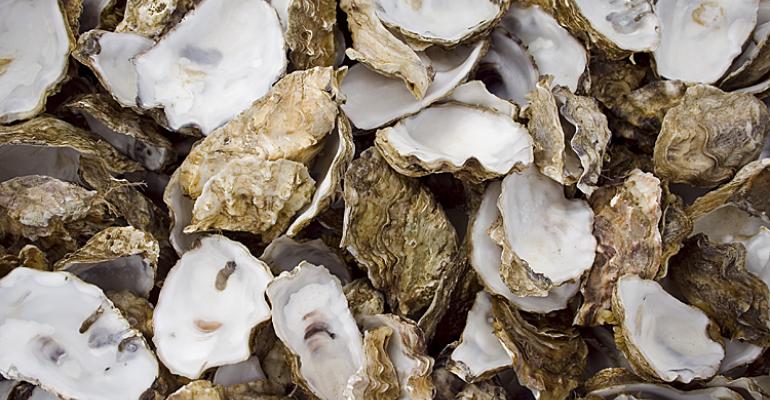Conservationists are calling on the community to help save and preserve the Chesapeake by recycling -- yes, recycling -- their shucked oyster shells.
Enjoying good oysters is just part and parcel of living in Maryland. Oyster consumption, both at home and in restaurants, has never been higher, putting stress on the Chesapeake Bay's oyster populations. But as popular as oysters are, environmentalists have drawn attention to the fact that there is a noticeable shortage of oyster shells -- yes, the discarded shells from after you've eaten the oyster. Believe it or not, oyster shells are recyclable and can actually help save the local oyster population that has been decimated over the years by pollution, overfishing, and disease. Every year, adult oysters in the Chesapeake release millions and millions of fertilized eggs in the summer months. As these baby oysters develop over the next two to three weeks, they swim freely without a shell. But once their development is complete, the young oysters must attach to a hard substrate (ideally, another oyster shell) in order to survive. Oysters that fail to find a suitable shell will perish. One of the key ways of preserving the oyster colonies in the Chesapeake is to return the discarded shells to the water so that they can be reused by new generations of oysters.
Every year, adult oysters in the Chesapeake release millions and millions of fertilized eggs in the summer months. As these baby oysters develop over the next two to three weeks, they swim freely without a shell. But once their development is complete, the young oysters must attach to a hard substrate (ideally, another oyster shell) in order to survive. Oysters that fail to find a suitable shell will perish. One of the key ways of preserving the oyster colonies in the Chesapeake is to return the discarded shells to the water so that they can be reused by new generations of oysters.
Beyond being a delicacy, healthy oyster populations are essential to maintaining the bay's ecosystem. A single adult oyster can filter upwards of 60 gallons of water a day. Healthy oyster beds are necessary to maintain good water quality. Oysters also play a large role in creating reefs, which other creatures rely on for food and habitat. These oyster reefs also help control beach erosion by serving as breakwaters that protect the shore from the full force of the surf.
That is why every recycled oyster shell makes a difference. In Maryland, the Chesapeake Oyster Alliance runs recycled oyster shell drop off locations. If you are going to recycle shells, please make sure you are only dropping off shells (and not trash). Also, only drop off oysters that are locally sourced. Recycling oyster shells harvested from other states runs the risk of introducing new diseases into the Chesapeake oyster population. Here are the spots in Maryland where you can currently donate your shucked oyster shells:
| Anglers Hunting Fishing Near Sandy Point State Park 1456 Whitehall Road Annapolis, MD (SOS bin out front under the Anglers sign) | Eastport Yacht Club 317 First Street Annapolis, MD | Oak Grove Marina Next to Yellowfin Restaurant 2820 Solomon's Island Rd, Suite A Edgewater, MD 21037 (SOS Cage Upper Parking Lot) Frederick, MD |
| Annapolis Yacht Club Sailing Center 6th St. and Severn, behind the Shell station Annapolis, MD | Breezy Point Marina 5230 Breezy Point Road Chesapeake Beach, MD 20732 | May's Restaurant 5640 Urbana Pike Frederick, MD 21704 |
| Chesapeake Bay Foundation Philip Merrill Center 6 Herndon Avenue Annapolis, MD (SOS Cage at Entrance to CBF) | Discovery Village 4800 Atwell Rd Shady Side, MD (Look for the Save Our Shell Cage) | Starbucks 573 Ritchie Hwy Severna Park, MD 21146 (SOS Cage Rear Parking Lot) |
It is also possible to reintroduce shucked oyster shells into the bay on your own, but experts recommend that you let the shells dry out for at least a couple months in order to help limit contamination. Again, make sure that if you go this route, you only recycle locally sourced oyster shells. In certain areas of the bay, it is estimated that 80 percent of an oyster class will contract Dermo or MSX, two deadly oyster diseases, by the time they reach their second year. While conservationists are fighting to stop these diseases, their work is made more difficult if foreign diseases are introduced into the areas.
 If you have a waterfront or water-access home, you can also help restore the Chesapeake Bay's oyster population by raising young oysters yourself! Don't worry, it's not nearly as time-intensive as raising a dog. The organization Marylanders Grow Oysters teams up with 1,500 waterfront property owners to raise baby oysters in cages suspended from docks and piers. This summer, there will be two million oysters planted in protected sanctuary beds that were raised by participants in the Marylanders Grow Oysters program. If you're interested in raising oysters, check out more program information here!
If you have a waterfront or water-access home, you can also help restore the Chesapeake Bay's oyster population by raising young oysters yourself! Don't worry, it's not nearly as time-intensive as raising a dog. The organization Marylanders Grow Oysters teams up with 1,500 waterfront property owners to raise baby oysters in cages suspended from docks and piers. This summer, there will be two million oysters planted in protected sanctuary beds that were raised by participants in the Marylanders Grow Oysters program. If you're interested in raising oysters, check out more program information here!
